2018 MITSUBISHI OUTLANDER III weight
[x] Cancel search: weightPage 341 of 441
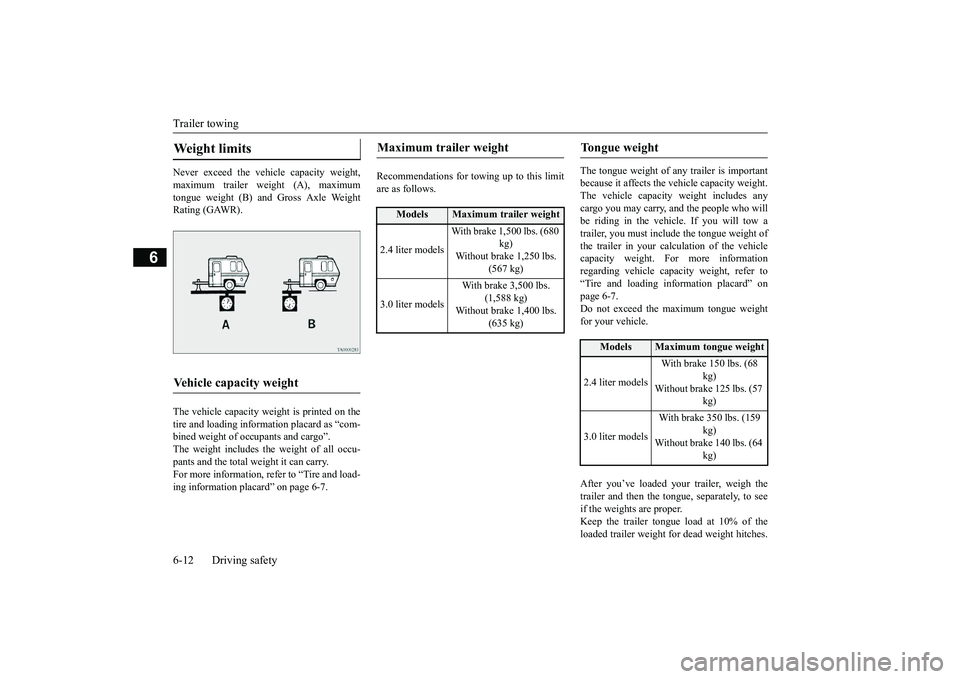
Trailer towing6-12 Driving safety
6
Never exceed the vehicle capacity weight,maximum trailer weight (A), maximumtongue weight (B) and Gross Axle WeightRating (GAWR).The vehicle capacity weight is printed on thetire and loading inform
ation placard as “com-
bined weight of oc
cupants and cargo”.
The weight includes the weight of all occu-pants and the total weight it can carry.For more information, refer to “Tire and load-ing information plac
ard” on page 6-7.
Recommendations for to
wing up to this limit
are as follows.
The tongue weight of a
ny trailer is important
because it affects the ve
hicle capacity weight.
The vehicle capacity weight includes anycargo you may carry, a
nd the people who will
be riding in the vehi
cle. If you will tow a
trailer, you must include the tongue weight ofthe trailer in your calculation of the vehiclecapacity weight. For more informationregarding vehicle capa
city weight, refer to
“Tire and loading information placard” onpage 6-7.Do not exceed the maximum tongue weightfor your vehicle.After you’ve loaded your trailer, weigh thetrailer and then the to
ngue, separately, to see
if the weights are proper.Keep the trailer tongue load at 10% of theloaded trailer weight fo
r dead weight hitches.
Weight limits Vehicle capacity weight
Maximum trailer weight
Models
Maximum trailer weight
2.4 liter models
With brake 1,500 lbs. (680
kg)
Without brake 1,250 lbs.
(567 kg)
3.0 liter models
With brake 3,500 lbs.
(1,588 kg)
Without brake 1,400 lbs.
(635 kg)
Tongue weight
Models
Maximum tongue weight
2.4 liter models
With brake 150 lbs. (68
kg)
Without brake 125 lbs. (57
kg)
3.0 liter models
With brake 350 lbs. (159
kg)
Without brake 140 lbs. (64
kg)
BK0249100US.book 12 ページ 2017年5月10日 水曜日 午前8時49分
Page 342 of 441
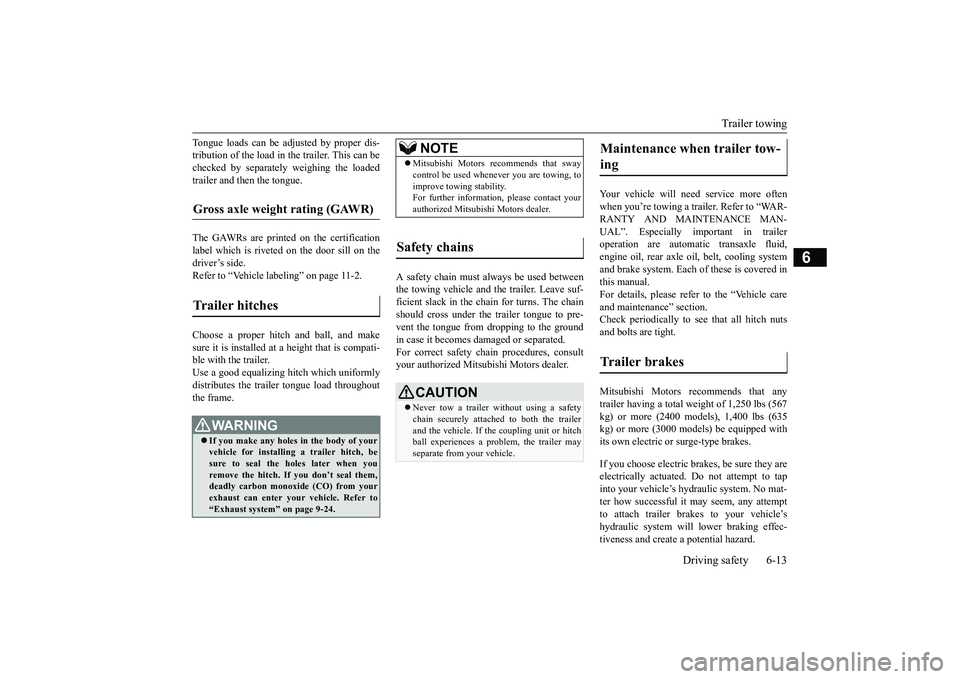
Trailer towing
Driving safety 6-13
6
Tongue loads can be adjusted by proper dis-tribution of the load in the trailer. This can bechecked by separately
weighing the loaded
trailer and then the tongue.The GAWRs are printed on the certificationlabel which is riveted on the door sill on thedriver’s side.Refer to “Vehicle labeling” on page 11-2.Choose a proper hitch and ball, and makesure it is installed at a height that is compati-ble with the trailer.Use a good equalizing hitch which uniformlydistributes the trailer tongue load throughoutthe frame.
A safety chain must al
ways be used between
the towing vehicle and the trailer. Leave suf-ficient slack in the chain for turns. The chainshould cross under the trailer tongue to pre-vent the tongue from dropping to the groundin case it becomes damaged or separated.For correct safety chai
n procedures, consult
your authorized Mitsub
ishi Motors dealer.
Your vehicle will need service more oftenwhen you’re towing a trailer. Refer to “WAR-RANTY AND MAINTENANCE MAN-UAL”. Especially important in traileroperation are automatic transaxle fluid,engine oil, rear axle
oil, belt, c
ooling system
and brake system. Each
of these is covered in
this manual.For details, please refer to the “Vehicle careand maintenance” section.Check periodically to see that all hitch nutsand bolts are tight.Mitsubishi Motors recommends that anytrailer having a total we
ight of 1,250 lbs (567
kg) or more (2400 models), 1,400 lbs (635kg) or more (3000 mode
ls) be equipped with
its own electric or surge-type brakes.If you choose electric br
akes, be sure they are
electrically actuated. Do not attempt to tapinto your vehicle’s hydraulic system. No mat-ter how successful it
may seem, any attempt
to attach trailer brakes to your vehicle’shydraulic system will lower braking effec-tiveness and create a potential hazard.
Gross axle weight rating (GAWR) Trailer hitches
WA R N I N GIf you make any holes in the body of yourvehicle for installing
a trailer hitch, be
sure to seal the holes later when youremove the hitch. If
you don’t seal them,
deadly carbon monoxide (CO) from yourexhaust can enter your vehicle. Refer to“Exhaust system” on page 9-24.
NOTE
Mitsubishi Motors recommends that swaycontrol be used whenever you are towing, toimprove towing stability.For further informati
on, please contact your
authorized Mitsubishi Motors dealer.
Safety chains
CAUTIONNever tow a trailer wi
thout using a safety
chain securely attached to both the trailerand the vehicle. If the
coupling unit or hitch
ball experiences a probl
em, the trailer may
separate from
your vehicle.
Maintenance when trailer tow-ing Trailer brakes
BK0249100US.book 13 ページ 2017年5月10日 水曜日 午前8時49分
Page 343 of 441

Trailer towing6-14 Driving safety
6
Trailer lights and equipment must complywith federal, state,
and local regulations.
Check with your loca
l recreational vehicle
dealer for the requirements in your area, anduse only equipment designed for your vehi-cle.Since lighting and wiring
vary by trailer type
and brand, you should have a qualified tech-nician install a suitable connector between thevehicle and the trailer.
Improper equipment or
installation can cause da
mage to your vehi-
cle’s electrical system
and affect your vehicle
warranty.Many states and Canadi
an provinces require
special outside mirrors when towing a trailer.Even if not required,
you should install spe-
cial mirrors if you ca
nnot clearly see behind
you, or if the trailer
creates a blind spot.
Ask your trailer sales or
rental agency if any
other items are recomm
ended or required for
your towing situation.
Towing a trailer requires a certain amount ofexperience.Before setting out for the open road, you’llwant to get to know your trailer. Acquaint
yourself with the feel of handling and brakingwith the added weight of the trailer. Alwayskeep in mind that the vehicle you are drivingis now a good deal longer and not nearly asresponsive as your vehicl
e is without a trailer.
Before you start, check the trailer hitch,safety chains, tires
and mirror adjustment.
Be sure your vehicle’s ti
res are inflated to the
cold inflation pressure listed in the manual.You’ll find these numbe
rs on the tire and
loading information placard at the sill of thedriver’s door.Refer to “Tire inflati
on pressures” on page
9-19.Stay at least twice as far behind the vehicleahead as you would when driving your vehi-cle without a trailer.
This can help you avoid
situations that require
heavy braking and sud-
den turns.
Trailer lights Additional trailer equipment
Operating hints
WA R N I N GIf you have a rear window open and youtow a trailer with
your vehicle, carbon
monoxide gas which
you cannot see or
smell could come into your vehicle. It cancause unconsciousness or death. Refer to“Exhaust system” on page 9-24.To maximize your safe
ty when towing a
trailer:Have your exhaust system inspected forleaks, and make necessary repairs beforestarting on your trip.Keep the rear windows closed.If exhaust does come into your vehiclethrough a window or
another opening,
drive with your front, main heating orcooling system on an
d with the blower on
any speed. This will
bring fresh, outside
air into your vehicle. Do not use recircula-tion because it only recirculates the airinside your vehicle. Refer to “Air selectionswitch” on page 7-9.
Driver preparation
Vehicle preparation Tire Following distance
BK0249100US.book 14 ページ 2017年5月10日 水曜日 午前8時49分
Page 368 of 441
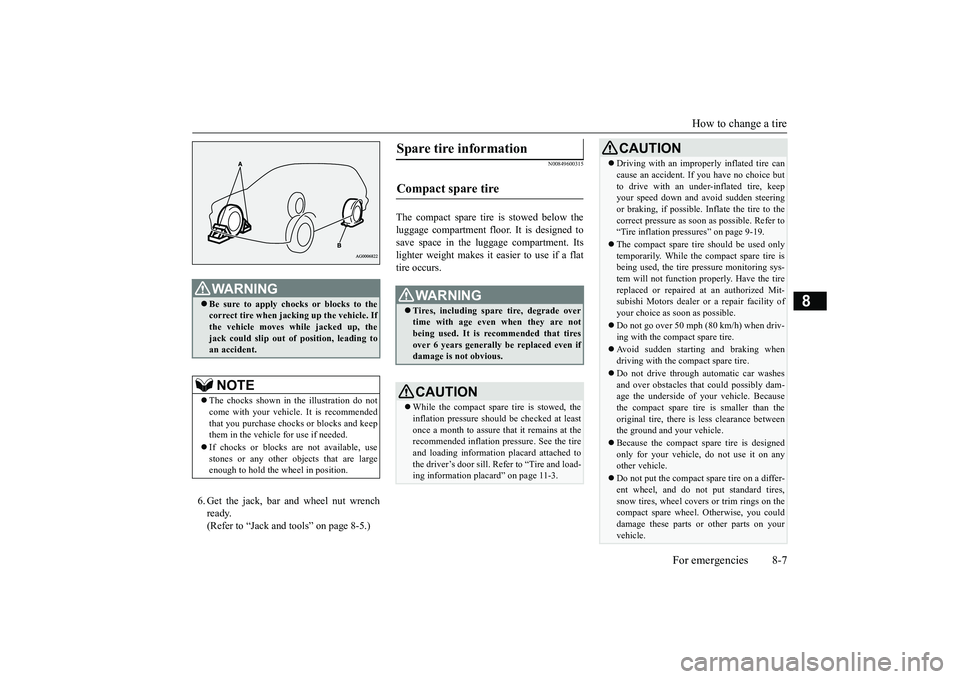
How to change a tire
For emergencies 8-7
8
6. Get the jack, bar and wheel nut wrenchready.(Refer to “Jack and t
ools” on page 8-5.)
N00849600315
The compact spare tire is stowed below theluggage compartment fl
oor. It is designed to
save space in the luggage compartment. Itslighter weight makes it easier to use if a flattire occurs.
WA R N I N GBe sure to apply choc
ks or blocks to the
correct tire when jacking up the vehicle. Ifthe vehicle moves while jacked up, thejack could slip out of
position, leading to
an accident.NOTE
The chocks shown in the illustration do notcome with your vehicl
e. It is recommended
that you purchase chocks or blocks and keepthem in the vehicle for use if needed.If chocks or blocks
are not available, use
stones or any other obj
ects that are large
enough to hold the wheel in position.
Spare tire information Compact spare tire
WA R N I N GTires, including spar
e tire, degrade over
time with age even when they are notbeing used. It is recommended that tiresover 6 years generally
be replaced even if
damage is not obvious.CAUTIONWhile the compact spare tire is stowed, theinflation pressure shoul
d be checked at least
once a month to assure that it remains at therecommended inflation pressure. See the tireand loading informati
on placard attached to
the driver’s door sill. Refer to “Tire and load-ing information placard” on page 11-3.
Driving with an imprope
rly inflated tire can
cause an accident. If
you have no choice but
to drive with an under-inflated tire, keepyour speed down and avoid sudden steeringor braking, if possible. Inflate the tire to thecorrect pressure as s
oon as possible. Refer to
“Tire inflation pressures” on page 9-19.The compact spare tire should be used onlytemporarily. While the compact spare tire isbeing used, the tire pr
essure monitoring sys-
tem will not function pr
operly. Have the tire
replaced or repaired at an authorized Mit-subishi Motors dealer or
a repair facility of
your choice as soon as possible.Do not go over 50 mph (80 km/h) when driv-ing with the compact spare tire.Avoid sudden starting and braking whendriving with the compact spare tire.Do not drive through automatic car washesand over obstacles that
could possibly dam-
age the underside of your vehicle. Becausethe compact spare tire is smaller than theoriginal tire, there is less clearance betweenthe ground and your vehicle.Because the compact spare tire is designedonly for your vehicle, do not use it on anyother vehicle.Do not put the compact spare tire on a differ-ent wheel, and do not put standard tires,snow tires, wheel covers
or trim rings on the
compact spare wheel. Otherwise, you coulddamage these parts or other parts on yourvehicle.CAUTION
BK0249100US.book 7 ページ 2017年5月10日 水曜日 午前8時49分
Page 381 of 441
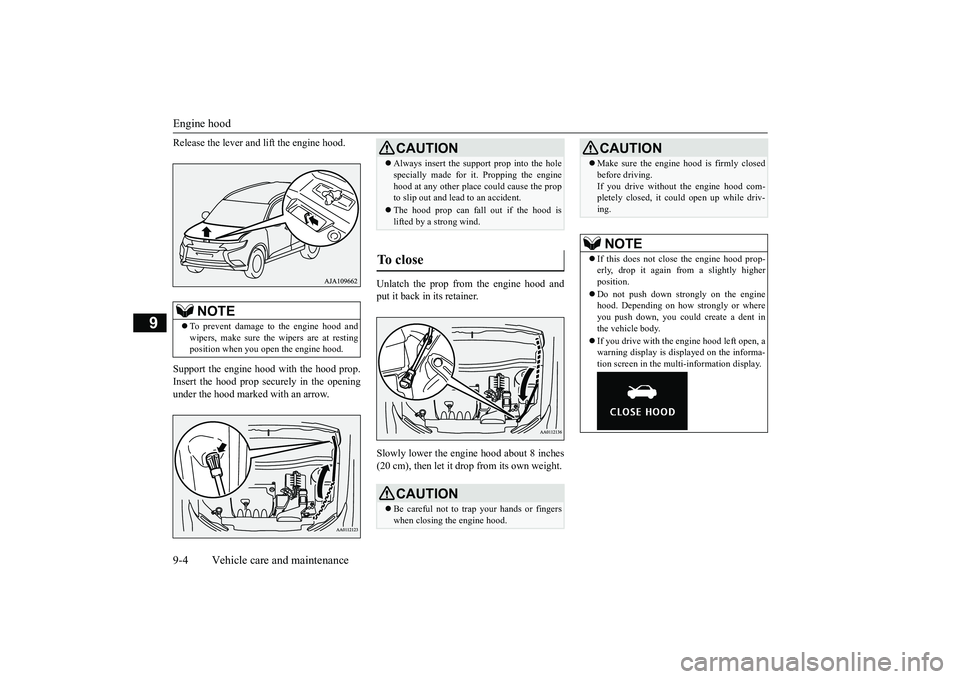
Engine hood9-4 Vehicle care and maintenance
9
Release the lever and
lift the engine hood.
Support the engine hood with the hood prop.Insert the hood prop securely in the openingunder the hood marked with an arrow.
Unlatch the prop from the engine hood andput it back in its retainer.Slowly lower the engine hood about 8 inches(20 cm), then let it drop from its own weight.
NOTE
To prevent damage to the engine hood andwipers, make sure the
wipers are at resting
position when you open the engine hood.
CAUTIONAlways insert the support prop into the holespecially made for it. Propping the enginehood at any other place
could cause the prop
to slip out and lead
to an accident.
The hood prop can fall out if the hood islifted by a strong wind.
To close
CAUTIONBe careful not to trap your hands or fingerswhen closing the engine hood.
Make sure the engine hood is firmly closedbefore driving.If you drive without the engine hood com-pletely closed, it c
ould open up while driv-
ing.NOTE
If this does not clos
e the engine hood prop-
erly, drop it again from a slightly higherposition.Do not push down strongly on the enginehood. Depending on how strongly or whereyou push down, you could create a dent inthe vehicle body.If you drive with the e
ngine hood left open, a
warning display is displayed on the informa-tion screen in the multi-information display.CAUTION
BK0249100US.book 4 ページ 2017年5月10日 水曜日 午前8時49分
Page 392 of 441

Tires
Vehicle care and maintenance 9-15
9
N00939201651
It is important to familiarize yourself with thefollowing terms:Cold tire pressure:• The measured pressure after the vehiclehas been parked for
at least three hours,
or• The measured pressure when the vehicleis driven less than 1 mile (1.6 km) afterhaving been parked for three hours.
Maximum pressure: the maximum per-missible cold tire inflation pressure forthis tire.Recommended inflation pressure: theinflation pressure for optimum tire perfor-mance.Intended outboard sidewall:• The sidewall that
contains a whitewall,
bears white lettering or bears manufac-turer, brand, and/or model name moldingthat is higher or deeper than the samemolding on the other sidewall of the tire,or
• The outward facing si
dewall of an asym-
metrical tire that has a particular sidethat must always face outward whenmounted on a vehicle.
Passenger car tire: a
tire intended for use
on passenger cars, multipurpose passen-ger vehicles, and trucks
that have a gross
vehicle weight rati
ng (GVWR) of 10,000
pounds or less.Light truck (LT) tire: a tire designated byits manufacturer as primarily intended foruse on lightweight truc
ks or multipurpose
passenger vehicles.Tread: portion of a ti
re that comes into
contact with the road.Tread rib: a tread se
ction running circum-
ferentially around a tire.Tread separation: pulling away of thetread from the tire carcass.Carcass: the tire structure, except treadand sidewall rubber wh
ich, when inflated,
bears the load.Sidewall: portion of
a tire between the
tread and bead.Section width: the lin
ear distance between
the exteriors of th
e sidewalls of an
inflated tire, excluding elevations due tolabeling, decoration,
or protective bands.
Bead: the part of the tire that is made ofsteel wires, wrapped or reinforced by plycords and that is shaped to fit the rim.
NOTE
Check each battery terminal for corrosion.You can prevent further corrosion by wash-ing with a solution of
baking soda and water.
Grease the posts and cl
amps after cleaning or
tightening them.Ensure the battery is securely installed andcannot be moved. Also
check each terminal
for tightness.If you will not be driv
ing your vehicle for a
long period of time, re
move the battery and
store it in a place where the battery fluid willnot freeze. The batter
y only should be stored
with a full charge.Before cleaning the battery, tighten all thefiller port caps to keep
dirt and moisture out.
Tires
WA R N I N GDriving with tires that are worn, damagedor improperly infl
ated is dangerous.
These type tire conditions will adverselyaffect vehicle performance.These type tire conditions can also cause atread separation or blowout which mayresult in an accident causing seriousinjury or death.
Tires, including spar
e tire, degrade over
time with age even when they are notbeing used.It is recommended that tires over 6 yearsgenerally be replaced
even if damage is
not obvious.WA R N I N G
BK0249100US.book 15 ページ 2017年5月10日 水曜日 午前8時49分
Page 396 of 441
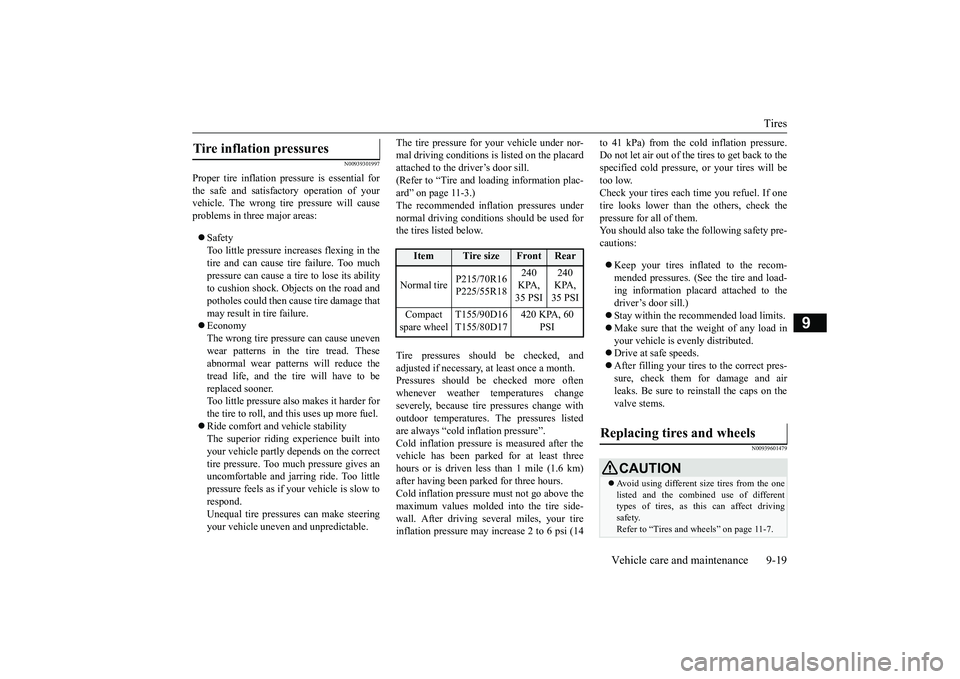
Tires
Vehicle care and maintenance 9-19
9
N00939301997
Proper tire inflation pre
ssure is essential for
the safe and satisfac
tory operation of your
vehicle. The wrong tire pressure will causeproblems in three major areas:SafetyToo little pressure increases flexing in thetire and can cause tire failure. Too muchpressure can cause a tire to lose its abilityto cushion shock. Objects on the road andpotholes could then ca
use tire damage that
may result in tire failure.EconomyThe wrong tire pressu
re can cause uneven
wear patterns in the tire tread. Theseabnormal wear patter
ns will reduce the
tread life, and the tire will have to bereplaced sooner.Too little pressure also makes it harder forthe tire to roll, and this uses up more fuel.Ride comfort and vehicle stabilityThe superior riding e
xperience built into
your vehicle partly de
pends on the correct
tire pressure. Too much pressure gives anuncomfortable and jarring ride. Too littlepressure feels as if
your vehicle is slow to
respond.Unequal tire pressure
s can make steering
your vehicle uneven
and unpredictable.
The tire pressure for your vehicle under nor-mal driving conditions is listed on the placardattached to the driver’s door sill.(Refer to “Tire and loading information plac-ard” on page 11-3.)The recommended inflation pressures undernormal driving conditions should be used forthe tires listed below.Tire pressures should be checked, andadjusted if necessary, at least once a month.Pressures should be checked more oftenwhenever weather temperatures changeseverely, becaus
e tire pressures change with
outdoor temperatures. The pressures listedare always “cold in
flation pressure”.
Cold inflation pressure is measured after thevehicle has been parked for at least threehours or is driven less than 1 mile (1.6 km)after having been parked for three hours.Cold inflation pressure must not go above themaximum values molded into the tire side-wall. After driving several miles, your tireinflation pressure may increase 2 to 6 psi (14
to 41 kPa) from the cold inflation pressure.Do not let air out of the tires to get back to thespecified cold pressure, or your tires will betoo low.Check your tires each t
ime you refuel. If one
tire looks lower than the others, check thepressure for all of them.You should also take the following safety pre-cautions:Keep your tires inflated to the recom-mended pressures. (See the tire and load-ing information placard attached to thedriver’s door sill.)Stay within the recommended load limits.Make sure that the weight of any load inyour vehicle is evenly distributed.Drive at safe speeds.After filling your tires to the correct pres-sure, check them for damage and airleaks. Be sure to reinstall the caps on thevalve stems.
N00939601479
Tire inflation pressures
Item
Tire size
Front
Rear
Normal tire
P215/70R16P225/55R18
240 KPA, 35 PSI
240 KPA, 35 PSI
Compact spare wheel
T155/90D16T155/80D17
420 KPA, 60
PSI
Replacing tires and wheels
CAUTIONAvoid using different size tires from the onelisted and the combined use of differenttypes of tires, as this can affect drivingsafety.Refer to “Tires and wheels” on page 11-7.
BK0249100US.book 19 ページ 2017年5月10日 水曜日 午前8時49分
Page 428 of 441
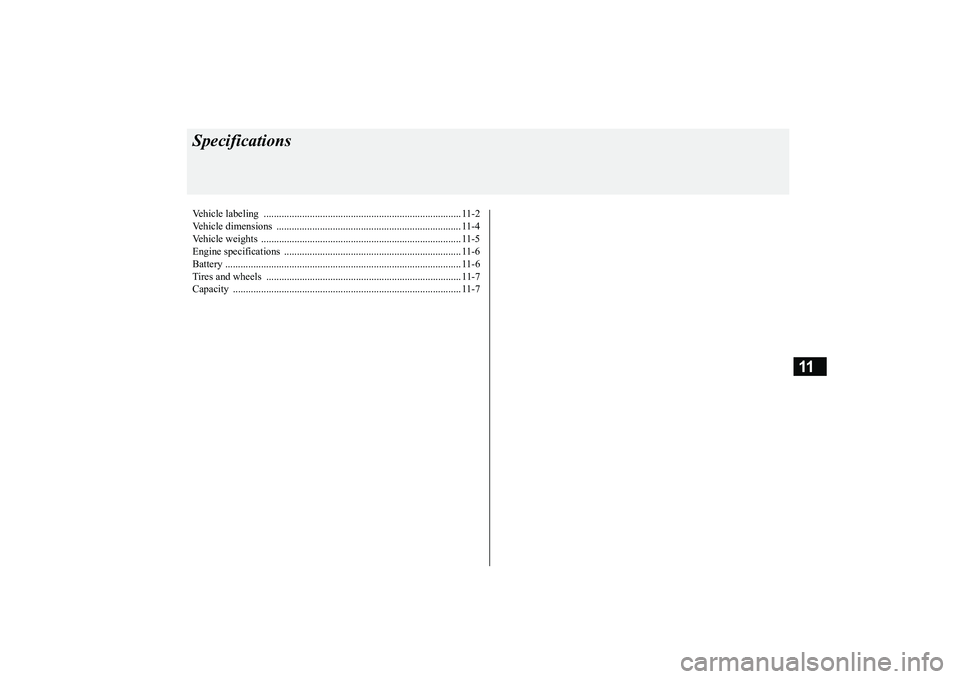
11
SpecificationsVehicle labeling ............................................................................. 11-2Vehicle dimensions ........................................................................ 11-4Vehicle weights .............................................................................. 11-5Engine specifications ..................................................................... 11-6Battery ............................................................................................ 11-6Tires and wheels ............................................................................ 11-7Capacity ......................................................................................... 11-7
BK0249100US.book 1 ページ 2017年5月10日 水曜日 午前8時49分